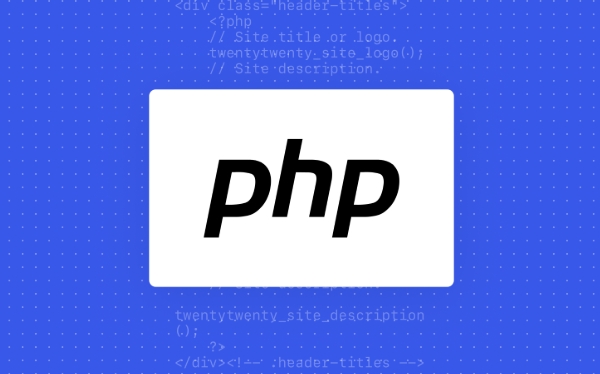__construct is a class constructor in PHP, not a normal function, it is automatically executed when creating an object. It is used to initialize object properties or set dependencies, does not require manual calls, can accept parameters, and replaces the construction method of the same name class in PHP4. For example, class User { public function __construct() { echo "User created!"; } } Automatically output information when creating an object. The difference between __construct and ordinary functions is that they are automatically executed, cannot be called manually, used for initialization, and have no return value. In addition, it can take parameters, such as class Product { private $name; public function __construct($name) { $this->name = $name; } }, and pass parameters when creating an object. Finally, it replaces PHP4's constructor, such as function User() in the User class. In short, __construct is a constructor of the PHP class, which is automatically run as a special method when the object is instantiated.

Yes, __construct is related to a function in PHP, but it's not exactly a regular function—it's a magic method used as a constructor in PHP classes.

What is __construct in PHP?
In PHP, when you create a new object from a class, PHP automatically looks for a method called __construct inside that class. If it exists, PHP runs that method right after the object is created. This makes __construct the standard way to set up initial logic or dependencies for an object.
For example:

class User {
public function __construct() {
echo "User created!";
}
}
$user = new User(); // Output: User created! Even though __construct is a method (a function inside a class), you don't call it directly like a normal function. It's invoked automatically by PHP when the object is instantiated.
How is __construct different from a regular function?
Here are a few key differences:

- ? Automatic execution : Unlike normal functions,
__constructruns automatically when an object is created. - ? Not manually called : You don't call
__construct()like you would a regular method, eg,$object->__construct(). - ? Used for setup : It's typically used to initialize properties or prepare the object for use.
- ? No return type needed : It doesn't return anything—it's meant for setup, not computing.
Can __construct take arguments?
Yes, it can accept arguments just like a normal function. These are passed during object creation.
Example:
class Product {
private $name;
public function __construct($name) {
$this->name = $name;
}
}
$book = new Product("PHP Basics"); // $name is passed hereSo, you can write a constructor with parameters, and you must provide those values when creating an object, unless you set default values in the method definition.
How does it compare to older PHP4-style constructors?
Before PHP5, a constructor was simply a method with the same name as the class:
class User {
public function User() { // PHP4-style constructor
// code
}
} This is outdated and deprecated in PHP5 and later. Using __construct is the modern and preferred way.
Summary
-
__constructis a magic method , not a standalone function. - It acts as the constructor for a PHP class.
- It runs automatically when an object is created.
- You can pass arguments to it.
- It replaces the old PHP4-style constructor.
So yes, while it's technically a method (not a global function), in PHP terms, it's often referred to as being a special kind of function—especially in casual conversation or tutorials.
Basically that's it.
The above is the detailed content of Is __construct considered a php function?. For more information, please follow other related articles on the PHP Chinese website!

Hot AI Tools

Undress AI Tool
Undress images for free

Undresser.AI Undress
AI-powered app for creating realistic nude photos

AI Clothes Remover
Online AI tool for removing clothes from photos.

Clothoff.io
AI clothes remover

Video Face Swap
Swap faces in any video effortlessly with our completely free AI face swap tool!

Hot Article

Hot Tools

Notepad++7.3.1
Easy-to-use and free code editor

SublimeText3 Chinese version
Chinese version, very easy to use

Zend Studio 13.0.1
Powerful PHP integrated development environment

Dreamweaver CS6
Visual web development tools

SublimeText3 Mac version
God-level code editing software (SublimeText3)
 PHP Variable Scope Explained
Jul 17, 2025 am 04:16 AM
PHP Variable Scope Explained
Jul 17, 2025 am 04:16 AM
Common problems and solutions for PHP variable scope include: 1. The global variable cannot be accessed within the function, and it needs to be passed in using the global keyword or parameter; 2. The static variable is declared with static, and it is only initialized once and the value is maintained between multiple calls; 3. Hyperglobal variables such as $_GET and $_POST can be used directly in any scope, but you need to pay attention to safe filtering; 4. Anonymous functions need to introduce parent scope variables through the use keyword, and when modifying external variables, you need to pass a reference. Mastering these rules can help avoid errors and improve code stability.
 How to handle File Uploads securely in PHP?
Jul 08, 2025 am 02:37 AM
How to handle File Uploads securely in PHP?
Jul 08, 2025 am 02:37 AM
To safely handle PHP file uploads, you need to verify the source and type, control the file name and path, set server restrictions, and process media files twice. 1. Verify the upload source to prevent CSRF through token and detect the real MIME type through finfo_file using whitelist control; 2. Rename the file to a random string and determine the extension to store it in a non-Web directory according to the detection type; 3. PHP configuration limits the upload size and temporary directory Nginx/Apache prohibits access to the upload directory; 4. The GD library resaves the pictures to clear potential malicious data.
 Commenting Out Code in PHP
Jul 18, 2025 am 04:57 AM
Commenting Out Code in PHP
Jul 18, 2025 am 04:57 AM
There are three common methods for PHP comment code: 1. Use // or # to block one line of code, and it is recommended to use //; 2. Use /.../ to wrap code blocks with multiple lines, which cannot be nested but can be crossed; 3. Combination skills comments such as using /if(){}/ to control logic blocks, or to improve efficiency with editor shortcut keys, you should pay attention to closing symbols and avoid nesting when using them.
 How Do Generators Work in PHP?
Jul 11, 2025 am 03:12 AM
How Do Generators Work in PHP?
Jul 11, 2025 am 03:12 AM
AgeneratorinPHPisamemory-efficientwaytoiterateoverlargedatasetsbyyieldingvaluesoneatatimeinsteadofreturningthemallatonce.1.Generatorsusetheyieldkeywordtoproducevaluesondemand,reducingmemoryusage.2.Theyareusefulforhandlingbigloops,readinglargefiles,or
 Tips for Writing PHP Comments
Jul 18, 2025 am 04:51 AM
Tips for Writing PHP Comments
Jul 18, 2025 am 04:51 AM
The key to writing PHP comments is to clarify the purpose and specifications. Comments should explain "why" rather than "what was done", avoiding redundancy or too simplicity. 1. Use a unified format, such as docblock (/*/) for class and method descriptions to improve readability and tool compatibility; 2. Emphasize the reasons behind the logic, such as why JS jumps need to be output manually; 3. Add an overview description before complex code, describe the process in steps, and help understand the overall idea; 4. Use TODO and FIXME rationally to mark to-do items and problems to facilitate subsequent tracking and collaboration. Good annotations can reduce communication costs and improve code maintenance efficiency.
 Quick PHP Installation Tutorial
Jul 18, 2025 am 04:52 AM
Quick PHP Installation Tutorial
Jul 18, 2025 am 04:52 AM
ToinstallPHPquickly,useXAMPPonWindowsorHomebrewonmacOS.1.OnWindows,downloadandinstallXAMPP,selectcomponents,startApache,andplacefilesinhtdocs.2.Alternatively,manuallyinstallPHPfromphp.netandsetupaserverlikeApache.3.OnmacOS,installHomebrew,thenrun'bre
 How to access a character in a string by index in PHP
Jul 12, 2025 am 03:15 AM
How to access a character in a string by index in PHP
Jul 12, 2025 am 03:15 AM
In PHP, you can use square brackets or curly braces to obtain string specific index characters, but square brackets are recommended; the index starts from 0, and the access outside the range returns a null value and cannot be assigned a value; mb_substr is required to handle multi-byte characters. For example: $str="hello";echo$str[0]; output h; and Chinese characters such as mb_substr($str,1,1) need to obtain the correct result; in actual applications, the length of the string should be checked before looping, dynamic strings need to be verified for validity, and multilingual projects recommend using multi-byte security functions uniformly.
 Learning PHP: A Beginner's Guide
Jul 18, 2025 am 04:54 AM
Learning PHP: A Beginner's Guide
Jul 18, 2025 am 04:54 AM
TolearnPHPeffectively,startbysettingupalocalserverenvironmentusingtoolslikeXAMPPandacodeeditorlikeVSCode.1)InstallXAMPPforApache,MySQL,andPHP.2)Useacodeeditorforsyntaxsupport.3)TestyoursetupwithasimplePHPfile.Next,learnPHPbasicsincludingvariables,ech






